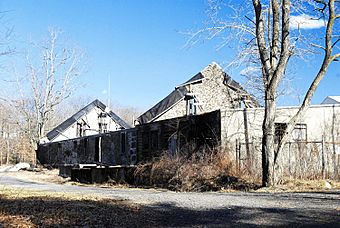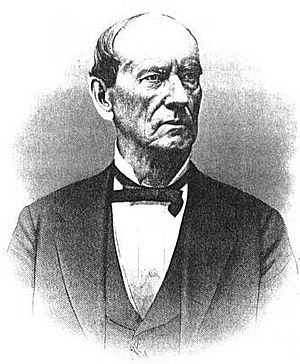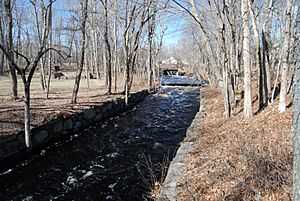Bridgewater Iron Works facts for kids
Quick facts for kids |
|
|
Bridgewater Iron Works
|
|

Remains of storage building.
|
|
| Lua error in Module:Location_map at line 420: attempt to index field 'wikibase' (a nil value). | |
| Location | Bridgewater, Massachusetts |
|---|---|
| Built | 1694 |
| NRHP reference No. | 01000087 |
| Added to NRHP | February 28, 2002 |
The Bridgewater Iron Works was a very important factory in Bridgewater, Massachusetts. It was located right by the Town River. This place was once called Lazell, Perkins and Company. By the mid-1800s, it became one of the biggest iron factories in the United States. They made large metal parts and strong metal shapes. Later, a company called Stanley Works bought the factory. The area around it is still known as Stanley today.
The factory was last used by the Bridgewater Foundry Company until 1988. Now, it is a small public park. You can still see parts of an old stone storage building there. This historic site was added to the National Register of Historic Places in 2002. This means it is a special place worth protecting.
Contents
History of the Iron Works
The story of this factory began in 1694. A man named David Perkins got permission to build a dam. This dam was built across the Town River. By 1707, Perkins had a blacksmith shop at this spot. A blacksmith makes things out of metal.
Early Mills and Growth
In 1785, two brothers, Isaac and Nathan Lazell, built a new type of mill. It was called a slitting mill. This mill could cut large sheets of iron into thinner strips. It was only the second such mill built in the country. This happened after the American Revolutionary War ended. Before the war, the British Crown had stopped new iron mills from being built.
A second slitting mill was added in 1793. By 1795, the Lazell brothers were making a lot of iron. They produced over 445 tons each year! A skilled mechanic named Jacob Perkins soon joined their company. He later became a partner in the business.
Making Cannons and More
From 1810 to 1816, the company was known as Lazell, Carey & Company. During the War of 1812, they made cannons for the war. They also made iron pots used in the whaling industry. Whaling was when people hunted whales for oil. The company also produced cut nails and iron hoops for wooden barrels.
In 1816, Mr. Carey passed away. The company was then renamed Lazell, Perkins & Company. In 1825, the company officially became the Bridgewater Iron Manufacturing Company. However, they still used the name Lazell, Perkins & Company for many years.
New Products and Leadership
In 1830, the company started making steam engines. They added many new buildings to the factory for this. But they stopped making steam engines after only a few years. They decided to focus on their main iron and foundry work. This included making the machines needed for their own production.
In 1835, Nathan Lazell, Jr. died. Nahum Stetson then became the company's treasurer. Stetson had worked there since 1825. He helped the company grow a lot. He also guided it through tough financial times. These were called the Panic of 1837 and Panic of 1857. A "panic" meant a big economic crisis. Stetson also worked with other iron factories nearby.
Railroad Connection and War Production
In 1845, the Fall River Railroad reached Bridgewater, Massachusetts. The next year, a train connection to Boston was finished. This made it much easier for the company to sell its products. The company grew very quickly during this time. By the early 1850s, it had 250 workers. About 10 acres of land were used for manufacturing. James Ferguson became the superintendent in 1856. He managed the daily work for many years.
By 1860, when the American Civil War began, Bridgewater Iron Company was one of the biggest in the country. They made heavy metal parts and strong metal shapes. They produced important parts for the United States Navy. This included pieces for famous iron-clad warships. These ships were the USS Monitor and the USS New Ironsides. They also made parts for the Pacific Mail Steamship Company. By 1868, the company had about 600 workers. They also made copper and brass tubes for steam boilers.
Changes and Later Uses
In 1899, the Stanley Works company bought the site. Stanley Works is known for making tools. They used the factory to make machinery and steel plates for their tools. The part of Bridgewater around the factory became known as Stanley. The company ran the site until 1928. Then, they moved their production to New Britain, Connecticut.
After that, the George O. Jenkins Company bought the site. They used it to store scrap paper. The property was badly damaged by a big storm in 1938. This storm was called the 1938 New England hurricane. Between 1946 and 1988, two buildings on the site were used by the Bridgewater Foundry Company. They made grey iron castings there.
What's There Now?
The property was given to the Town of Bridgewater in 1994. This was a gift from the Brousseau and Landner families. They were the last owners of the foundry. Much of the site has now been turned into Ironworks Park.
The park has a small bridge over the Town River. You can also see the remains of several old buildings. Another part of the property is now used by the town's highway department.



